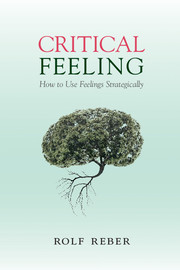1 - Critical thinking
from Part I - The basics of critical feeling
Published online by Cambridge University Press: 05 March 2016
Summary
It is a narrow mind that cannot look at subjects from various points of view.
(George Eliot 1994/1871, p. 54)Reasoning as a basis for judgment and decision making is a keystone of modern Western culture. Modern society aims to educate an intellectually mature citizenry that overcomes fallacies, biases, superstition, and adherence to unquestioned authority. One offshoot of this emphasis on reasoning is the critical thinking movement that emerged in the 1960s in the philosophy of education. This movement responded to the observation that even well-educated people possessed inadequate reasoning skills (Pritchard 2014). Philosophers argued that one objective of school and college education should be the training of critical thinking. Students should be able to form beliefs or to make decisions by proper reasoning. These proficiencies can be applied to the subjects taught at school and be transferred to everyday life (see Fisher 2011). Critical thinking goes beyond the reasoning abilities examined in cognitive psychology: It relies not on descriptions of how people actually think but on prescriptions for how they should think. Such prescriptions cannot be determined by empirical research because they derive from norms and values that are beyond scientific scrutiny; they are therefore often neglected in scientific discourse (see Wecker 2013 for an interesting discussion on prescriptive statements in education).
In this chapter, the main focus will be on the prescriptive part of critical thinking because critical feeling serves similar objectives to critical thinking. It is necessary to unveil the objectives of critical thinking and why it is insufficient to serve these purposes. Together with the next chapter (on the psychology of feelings), this discussion will set the stage to introduce critical feeling. In this chapter, I first consider critical thinking as a skill and examine its strengths before looking at how critical thinking may serve values. At the end of the chapter, I discuss the neglect of feelings in critical thinking and why critical thinking is not enough.
Critical thinking as a skill
Critical thinking has been defined as “correct assessing of statements” (Ennis 1962, p. 83) and as “reasonable, reflective thinking that is focused on deciding what to believe or do” (Fisher 2011, p. 4). Critical thinking is thinking because it utilizes reasoning capacities and abilities to decide what to believe and what to do.
- Type
- Chapter
- Information
- Critical FeelingHow to Use Feelings Strategically, pp. 9 - 33Publisher: Cambridge University PressPrint publication year: 2016



